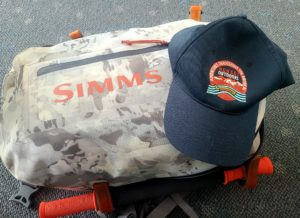
This past July and into the first week of August I had the opportunity to return to King Salmon, Alaska and fish a week at Rapids Camp Lodge. I have been blessed with being invited there 5 years in a row. Although I almost feel like family with the staff and owners, I will never stop being grateful and appreciative of the incredible opportunity they provide me and just how lucky I am. Rapids is a high-end lodge. It is pricey and they offer no apology for that nor should they.
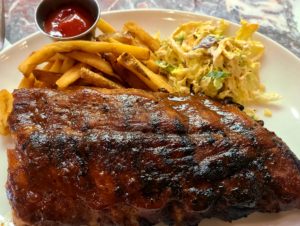
The accommodations, food, service and daily fly-out program that Rapids Camp delivers is simply spectacular. It goes without saying that the fishing is out-of-this-world too. Each morning you get to hop in a plane and fly 30 – 60 minutes to some remote river or lake. This pretty much guarantees insane fishing. You don’t see other boats, anglers or outfitter, just the occasional bear. These are the trips, the adventures and stories that dreams are made of. Each year when I return there are always 1 or 2 new guides. I get the pleasure of fishing with old friends and, making new ones. When I arrive, all the guides know it will be a “tenkara week” and they’re always excited to see it in action. The returning guides are confident and relaxed with tenkara. The new ones are curious and interested. This is one of the many reasons why I love Rapids Camp. Their guides are incredibly knowledgeable and amazing anglers, and they’re always positive and excited to learn something new. They have no fear. They aren’t heroes. They’re flexible, they want to have fun and just get you into as many fish as possible. Your success is their success.
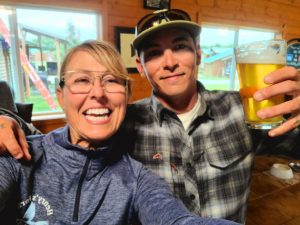 When I pack gear, I typically bring a Sagi, Taka and/or Kyojin tenkara rod depending on when I’m traveling and which species are expected in during the time I’m at the lodge. This last week in July was going to be a rainbow and dolly fest. Chum salmon were just arriving and the silvers hadn’t shown up yet. Based on this, I decided to bring along my Suimenka Dual Action Zoom tenkara rod, a rod that in my opinion, is underused and underappreciated not only by the angling community but also by me.
When I pack gear, I typically bring a Sagi, Taka and/or Kyojin tenkara rod depending on when I’m traveling and which species are expected in during the time I’m at the lodge. This last week in July was going to be a rainbow and dolly fest. Chum salmon were just arriving and the silvers hadn’t shown up yet. Based on this, I decided to bring along my Suimenka Dual Action Zoom tenkara rod, a rod that in my opinion, is underused and underappreciated not only by the angling community but also by me.
The Suimenka rod is quite unique. Not only is it a zoom rod that fishes at 9′ and 11′, but it also comes with two different tip sections which not only change the length of the rod to a 10′ and 12′ rod, but also changes the flex, action and feel of the rod. There simply is not another rod on the market that does this. Most people when they first pick up this rod, describe it as an ultralight 9ft 5wt. It just has that familiar feel in the hand and is exceptionally well balanced. It has backbone and a stiffer tip for casting very heavy setup such as you might use for nymphing deep holes in fast water or for throwing heavier streamers. You get incredible sensitivity and control over your fly, plus an instant hookset. The Suimenka will cast all kinds of lines and allow you to do the most discrete and precise manipulations of your fly.
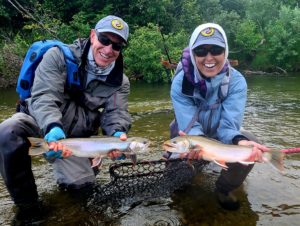
Switch the tip section out to the softer version, and now you have a tenkara fly rod that feels and performs with extreme airiness, delicacy and accuracy. Soft, subtle dry flies can be cast into tight spots with amazing grace. Dance a terrestrial pattern on the surface or skate a Sakasa Kebari on the top of the water with this softer setup and it feels like you have a whole different rod. Plus, you also gain length and stealth with a 10’/12′ reach. Talk about versatility. Only a Zen Tenkara rod can deliver that kind of innovation.
Although I’ve used this rod extensively for rainbows and browns on my home waters in Colorado, I decided to bring a Suimenka along to Alaska and see just what this rod could do when put to the test on much bigger fish. Many of the rivers in Alaska are perfectly sized for this fixed line method and, for a slightly shorter rod than the traditional 12 footers. Rivers range on average in size from 15-40 feet across.. Most are completely wadable. Although the Sagi has accompanied me to Alaska every year, and clients in Alaska have chosen to use this rod most often the Suimenka, with it’s shorter length but big backbone, should perform ideally on tighter water without giving up any control during the play.
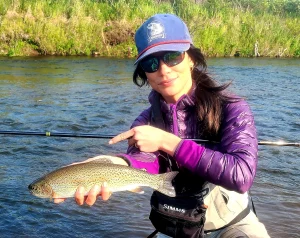
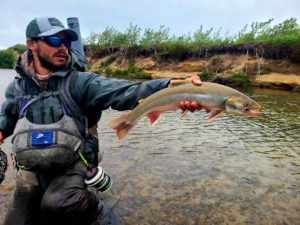
Places like Feathery, Contact and the Funnel are all small destination rivers with big fish. Even our favorite grayling water, the Narrows, which is substantially wider at about 100′, is still wadable from side to side. The Suimenka has a FRAE Rating of a 6wt. Getting into big dollies and rainbows that can reach 24″ would be a test of the rod’s ability to manage, absorb and hang on to these robust fish. I brought a variety of line lengths but ended up using the Fusion Line Small/15′ almost exclusively. Paired with an 8′ leader/tippet set up, I was consistently “in the zone”, able to reach my targets and had little to no difficulty covering all the water.
When I “destination fish”, particularly when I’m combining the trip with a rod test, I often like to fish along side a rod and reel set up. This gives me perspective on overall performance, productivity, landing time and a few other data I find helpful and informative when understanding a rod’s capacity and it’s limitations. What I consistently find is that landing time on a tenkara rod is almost always quicker than a rod and reel setup. For the entire week, I and my counterpart were pretty much neck to neck, with tenkara being just slightly ahead in numbers. I attribute this to speed in which you land fish on a fixed line. Quicker landings translates into more time prospecting and targeting. It’s rare when the advantage is reversed.
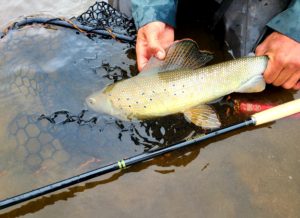
My personal preference is to fish the Suimenka with the softer tip. I found casting this combination to be pure pleasure. It kept me relaxed and paced and I could place my fly exactly where I wanted it. I fished the rod “fusion style” meaning, with the line laid out on the surface of the water and giving it an occasional mend. Most days I used 10lb test and never had to go up past 12lb. During the entire week I had two fish break off but this was due in part to a combination of user error and silliness with taking videos. It also happens on a reel setup too so it wasn’t of much concern. In fact, my counterpart also lost a few fish to break-offs. Such is fishing.
The guides and I kept hoping silvers would start arriving and we’d get a chance to cast at a few. I’ve already landed this species on the Kyojin tenkara rod, but wanted a chance to see if it was possible using the Suimenka. The silvers never showed up during the week but to be clear, no one was complaining. At the end of each day we’d hike back to the plane where a cold beer was waiting for us. On the flight home, relishing that “good exhaustion” sensation, we would tally the total number of fish we’d landed for the day. It was mind boggling, particularly when you realize you stopped counting. Then, you know the numbers were truly crazy.
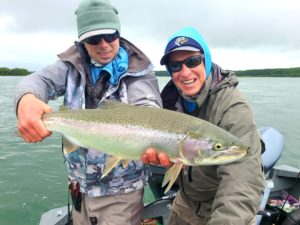
Once back at the lodge, cleaned up and showered, the bar was the meetup place not only for cocktails but also for sharing fish pictures, stories and adventures of the day with the other anglers, guests and guides. That sharing time was made even better with delicious hors d’oeuvres – a cherished tradition with anglers around the word: fish, cocktails, food. The stories are filled with joy, satisfaction, bravery, loses, beauty, nature and life-long memories. The drugs that keep pulling us back to these rivers and fish.
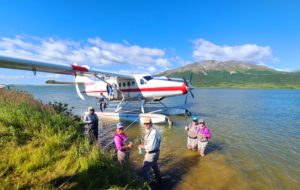
The Suimenka performed. Seamlessly actually. Guides landed fish on it. New anglers landed fish on it. Experienced fly fishermen who had never used a tenkara rod, landed fish on it and I, landed fish on it. It was a rainbow dolly sort of week, combined with a Suimenka tenkara rod adventure. Everyone enjoyed the rod and everyone enjoyed themselves. Rapids Camp Lodge once again, totally delivered. Thank you to owners Amy and Dan Herrig, to the fantastic guides, and to all the inhouse staff that make the stay there so magnificent. YOU, are the ones that make dreams come true and memories of a lifetime for your guests.
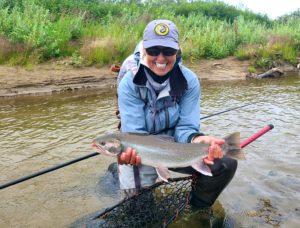




Hi, I appreciate your article as I’m very interested in fishing with a Tenkara Fly Rod, especially the Zen Suimenka rod. That said, I know very little about the tools and methods.
I’ve got three questions:
1. You use the “Fusion Line Small/15′”; however, it looks like it’s now called the “Zen Fusion Tenkara Line: LIGHT.” Is that what you’re referring to?
2. Do I need to purchase the“8′ leader/tippet set up separately, or does it come with the Suimenka rod?
3. Can you recommend a few flies for mid-larger fish?
Let’s give it a go:
1. Is the “Fusion Line Small/15′” line now called the “Zen Fusion Tenkara Line: LIGHT”?
We offer several lines. Our Furled lines, our All Purpose Lines and our Fusion Lines. The Fusion Lines have always come in three different grain weights – LIGHT, MIDWEIGHT and BIG. We never called our Fusion Lines “small” so not sure about that. Maybe they were mislabeled or names somewhere?
2. Do I need to purchase the“8′ leader/tippet set up separately, or does it come with the Suimenka rod?
All of our tenkara rods come with a rod sock, a spare tip section, and a hard carbon fiber travel case. Lines are sold separately. We do offer a Grab-n-Go Kit which comes complete with a Zako Tenkara Rod, a Furled 11ft Hi-Vis Line, an EVA Foam Spool/Line Holder and a Dozen Sakasa Kebari Flies.
The Suimenka rod that you are interested in can cast a variety of lines from the All Purpose (for a lighter feel and presentation), to the Fusion Lines in both the LIGHT and the MIDWEIGHT (for longer casts and a feel like a regular fly cast). While the Suimenka can cast the Fusion Line BIG, it is not my personal preference.
3. Can you recommend flies for mid-large fish?
To answer that I would need to know the species you are targeting. You can use any fly or fly combination that you would use on a regular fly rod. Tenkara rods can cast “tenkara flies”. But you can also use dry flies, nymphs, streamers, dry dropper combos and double nymphs. Anything you would tie on a regular fly rod, you can use on a tenkara rod.
Hope you find this helpful. Please reach out with any other questions you may have. Always happy to help and support.
Tight lines and happy fishing.